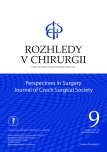Acute appendicitis during the spring COVID-19 pandemic in 2020 – a comparative retrospective study
Authors:
L. Hána; M. Ryska; Radek Pohnán
Authors‘ workplace:
Chirurgická klinika 2. lékařské fakulty Univerzity Karlovy a Ústřední vojenské nemocnice – Vojenské fakultní, nemocnice Praha
Published in:
Rozhl. Chir., 2021, roč. 100, č. 9, s. 429-434.
Category:
Original articles
doi:
https://doi.org/10.33699/PIS.2021.100.9.429–434
Overview
Introduction: Acute appendicitis (AA) is the most common abdominal emergency. This article aims to document the impact of the ongoing COVID-19 pandemic on timely diagnosis of AA, duration of symptoms before examination in a medical institution, levels of laboratory inflammatory markers, and the length of hospital stay. Collected data were compared with current world literature.
Method: Two datasets were created, comprising patients with the histological diagnosis of AA determined from March 1 to June 30, 2019 (before of the onset of the COVID-19 pandemic) and in the same period of the spring pandemic of COVID-19 in 2020. The following information was obtained from patient medical records: Demographic data, information on symptom duration before AA diagnosis, information on laboratory inflammatory marker levels, the used surgical method, antibiotic treatment, histopathological findings, and the length of hospital stay. These data were processed using descriptive statistics methods and the two created datasets were compared with the use of statistical methods (an unpaired t-test and Welch’s t-test).
Results: Thirty seven patients (26 men and 11 women) with the median age of 41 years were operated on for acute appendicitis at the Department of Surgery, Military University Hospital in Prague from March 1 to June 30, 2019. Thirty four patients (19 men and 15 women) with the median age of 42 years were operated on in the same period of 2020. No significant differences were found between these two compared datasets in terms of symptom duration, laboratory inflammatory marker levels or the length of hospital stay. The distributions of histopathological findings and used antibiotic treatments were also similar.
Conclusion: In our study, we were unable to demonstrate any statistically significant differences between the datasets of patients operated on before and after the onset of the COVID-19 pandemic.
Keywords:
acute appendicitis − COVID-19 – appendectomy − conservative treatment
Sources
1. Ferko A, Šubrt Z, Dědek T. Chirurgie v kostce. Praha, Grada Publishing 2015.
2. Ceresoli M, Zucchi A, Allievi N, et al. Acute appendicitis: Epidemiology, treatment and outcomes – analysis of 16544 consecutive cases. World J Gastrointest Surg. 2016;8(10):693–699. doi: 10.4240/ wjgs.v8.i10.693.
3. Sartelli M, Baiocchi GL, Di Saverio S, et al. Prospective observational study on acute appendicitis worldwide (POSAW). World J Emerg Surg. 2018;13 : 19. doi: 10.1186/ s13017-018-0179-0.
4. Menclová K, Traboulsi E, Nikov A, et al. Treatment of acute appendicitis: Retrospective analysis. Rozhl Chir. 2016;95(8):317−321.
5. Le D, Rusin W, Hill B, et al. Post-operative antibiotic use in nonperforated appendicitis. Am J Surg. 2009;198(6):748−752. doi: 10.1016/j.amjsurg.2009.05.028.
6. Soukup P. Nesprávná užívání statistické významnosti a jejich možná řešení. Data a výzkum – SDA Info 2010;4(2):77−104.
7. Wu F, Zhao S, Yu B, et al. A new coronavirus associated with human respiratory disease in China. Nature 2020;579(7798):265–269. doi: 10.1038/ s41586-020-2008-3.
8. Köhler F, Acar L, van den Berg A, et al. Impact of the COVID-19 pandemic on appendicitis treatment in Germany-a population - based analysis. Langenbecks Arch Surg. 2021;406(2):377−383. doi:10.1007/ s00423-021-02081-4.
9. Romero J, Valencia S, Guerrero A. Acute appendicitis during coronavirus disease 2019 (COVID-19): Changes in clinical presentation and CT findings. J Am Coll Radiol. 2020;17(8):1011−1013. doi: 10.1016/j. jacr.2020.06.002.
10. Tankel J, Keinan A, Blich O, et al. The decreasing incidence of acute appendicitis during COVID-19: A retrospective multi-centre study. World J Surg. 2020;44(8):2458−2463. doi:10.1007/ s00268-020-05599-8.
11. Orthopoulos G, Santone E, Izzo F, et al. Increasing incidence of complicated appendicitis during COVID-19 pandemic. Am J Surg. 2020;S0002−9610(20)30595-X. doi:10.1016/j.amjsurg.2020.09.026.
12. Finkelstein P, Picado O, Muddasani K, et al. A retrospective analysis of the trends in acute appendicitis during the COVID-19 pandemic. J Laparoendosc Adv Surg Tech A. 2021;31(3):243−246. doi:10.1089/ lap.2020.0749.
13. Antakia R, Xanthis A, Georgiades F, et al. Acute appendicitis management during the COVID-19 pandemic: A prospective cohort study from a large UK centre. Int J Surg. 2021;86 : 32−37. doi:10.1016/j. ijsu.2020.12.009.
14. Javanmard-Emamghissi H, Boyd-Carson H, Hollyman M, et al. The management of adult appendicitis during the COVID-19 pandemic: an interim analysis of a UK cohort study. Tech Coloproctol. 2021 Apr;25(4):401−411. doi:10.1007/s10151-020-02297-4.
15. Ganesh R, Lucocq J, Ekpete NO, et al. Management of appendicitis during COVID-19 pandemic; short-term outcomes. Scott Med J. 2020;65(4):144−148. doi:10.1177/0036933020956316.
16. Lock JF, Wiegering A. Changes in the management of acute appendicitis during the COVID-19 pandemic. Langenbecks Arch Surg. 2021;406(2):503−504. doi:10.1007/s00423-021-02099-8.
17. Collard M, Lakkis Z, Loriau J, et al. Antibiotics alone as an alternative to appendectomy for uncomplicated acute appendicitis in adults: Changes in treatment modalities related to the COVID-19 health crisis. J Visc Surg. 2020;157(3S1):S33−S42. doi:10.1016/j.jviscsurg.2020.04.014.
Labels
Surgery Orthopaedics Trauma surgeryArticle was published in
Perspectives in Surgery

2021 Issue 9
Most read in this issue
- Prehabilitation, improving postoperative outcomes
- Laparoscopic versus open hernia repair in patients with incarcerated inguinal hernia
- Omental torsion as a possible cause of acute abdomen
- Atestace
